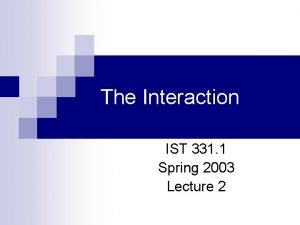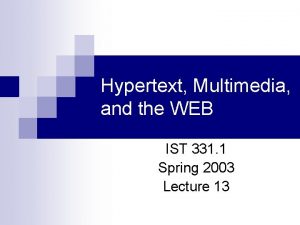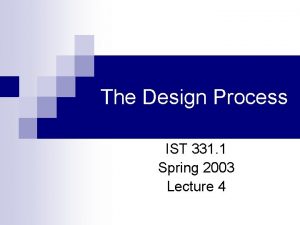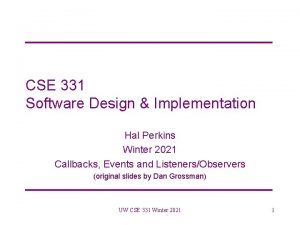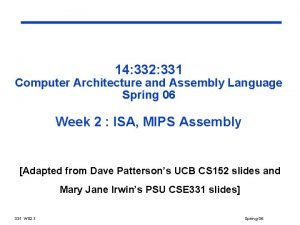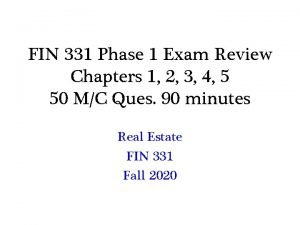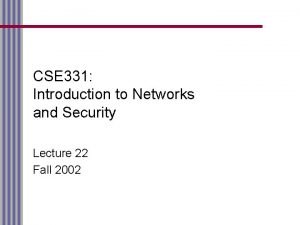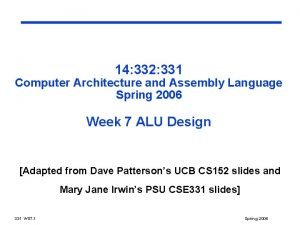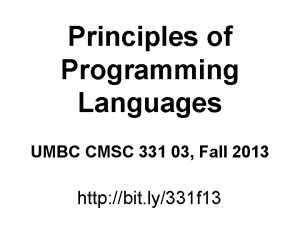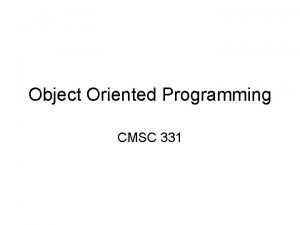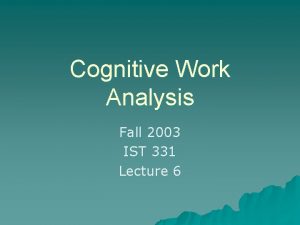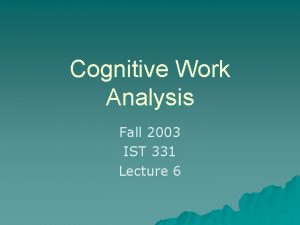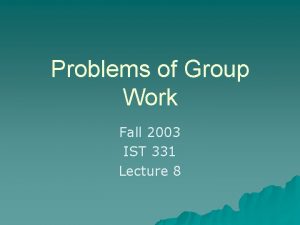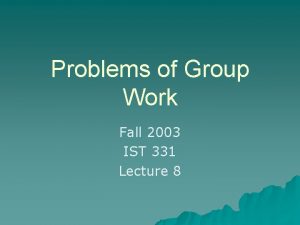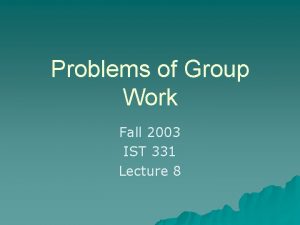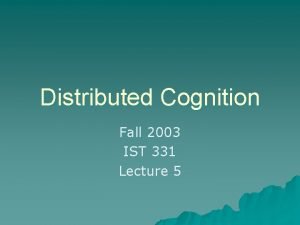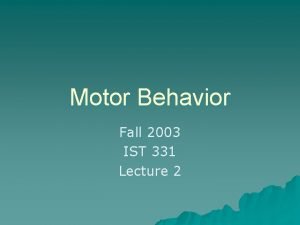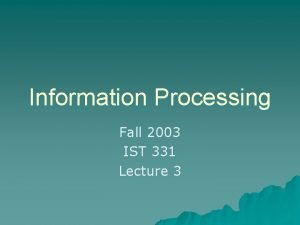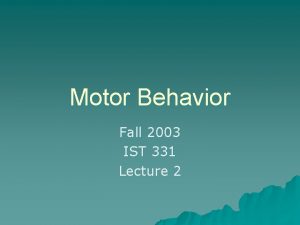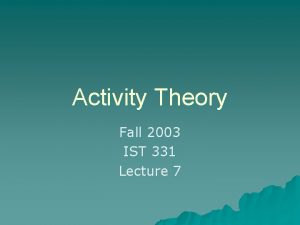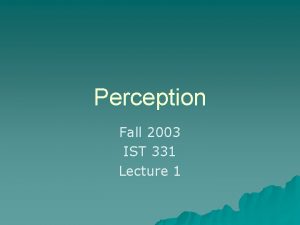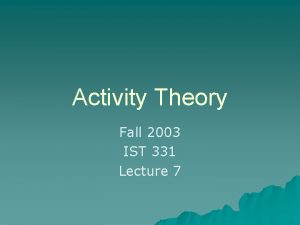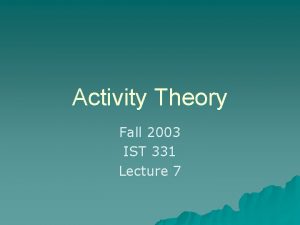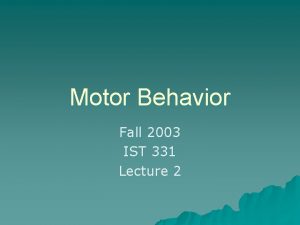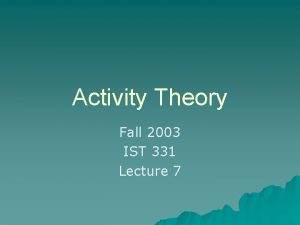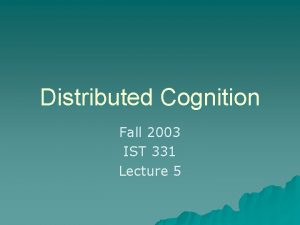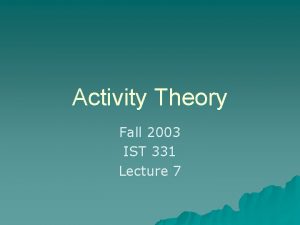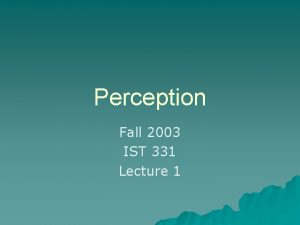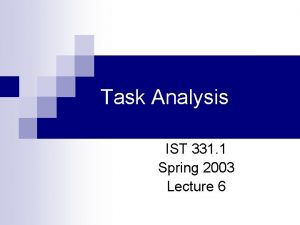Cognitive Work Analysis Fall 2003 IST 331 Lecture




















- Slides: 20

Cognitive Work Analysis Fall 2003 IST 331 Lecture 6

Cognitive Work Analysis u An approach to analyzing human cognition to help designers build interfaces that let human operators safely handle unanticipated abnormalities and faults – Three Mile Island

Cognitive Work Analysis Human cognitive work in complex real-time systems u Grew out of Cognitive Engineering u – With relation to Ecological Interface Design

Cognitive Work Analysis u External physical system being controlled – Determine what the correct model of the system is – Possibilities for action – As in the Three Mile Island event

Cognitive Work Analysis Figure 9. 6, page 240

Cognitive Work Analysis u Work Domain Analysis – Set of physical and purposive constraints within which activity takes place – Purposive means the reasons that a technical system exists and needs to be controlled – Analysis of fields of constraints – Example: directions to go some place vs. map which displays constraints

Cognitive Work Analysis u Control Task Analysis – Defines what needs to be done for a work domain to be effectively controlled – Independent of how or by whom u Human or automated system – Take the form of decision ladder or maps of control task coordination – Example: air defense work pg. 244

Cognitive Work Analysis u Strategies Analysis – How control tasks can be done is analyzed – Control tasks can be done in many different ways u Costs and benefits of each method – Results in flowchart of strategies – Example: pg. 247

Cognitive Work Analysis u Social-Organizational Analysis – How responsibilities for executing strategies are divided among u Humans and automation u How different agents might communicate with each other – Factors considered include load sharing, to couple or decouple functions, safety, etc. – Social organization for communications u Autocratic organization u Authority hierarchy u Etc.

Cognitive Work Analysis u Worker Competencies Analysis – Classify different kinds of cognitive control needed by human operators – Skills-Rules-Knowledge taxonomy tool u Skill-based behavior u Rule-based behavior u Knowledge-based behavior – Experienced operator will move fluently between different levels of cognitive control in response to a work situation

Cognitive Work Analysis

Cognitive Work Analysis u Analysis narrows down to the functional action possibilities by classifying different kinds of cognitive control

System Life Cycle u System Life Cycle – Requirements definition – Modeling and simulation – Tender evaluation – Operator training – System upgrade – System decommissioning u Cognitive Work Analysis can be applied to each stage of the System Life Cycle

Case Applied u Commonwealth of Australia’s Airborne Early Warning and Control defense platform

Language Use

Language u Human-human interaction – HCI looks at communication using electronic media – Some theories look at language as a cognitive process – Others look at language as a social process – Herbert Clark bridges 2 camps u Design of facilities to electronically mediate communication

Language u Clark based on common ground – Different kinds of common ground – Collaboration is a joint action – Common ground is developed through joint action u Example:

Language u Face-to-Face Conversation – More then words u Hands u Face u Eyes u Body – Joint action involving 2 or more people – Use common ground to minimize effort required to communicate – Conversation tests, reformulates, and adds to our common ground

Time / Space Matrix u Common axis names: – Time: synchronous / asynchronous – Place: co-located / remote Non-computer communications

Case
 Ist 331
Ist 331 Ist 331
Ist 331 Ist spring design
Ist spring design Cognitive and non cognitive religious language
Cognitive and non cognitive religious language Cast of spring, summer, fall, winter... and spring
Cast of spring, summer, fall, winter... and spring 01:640:244 lecture notes - lecture 15: plat, idah, farad
01:640:244 lecture notes - lecture 15: plat, idah, farad Winter kommt flocken fallen nieder
Winter kommt flocken fallen nieder Was ist deine lieblingsjahreszeit
Was ist deine lieblingsjahreszeit Es ist herbst bunte blätter fliegen
Es ist herbst bunte blätter fliegen Es ist herbst es ist herbst bunter blätter fliegen
Es ist herbst es ist herbst bunter blätter fliegen Zu glauben ist schwer. nichts zu glauben ist unmöglich
Zu glauben ist schwer. nichts zu glauben ist unmöglich Transportation planing
Transportation planing Ssis 331
Ssis 331 Uw cse 331
Uw cse 331 14:332:331
14:332:331 14:332:331
14:332:331 Affirmative easement
Affirmative easement Cse 331
Cse 331 Cse 332 p3
Cse 332 p3 Cmsc 331
Cmsc 331 Cmsc 331
Cmsc 331
